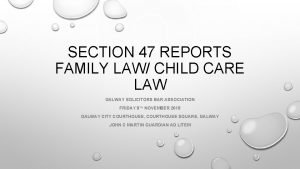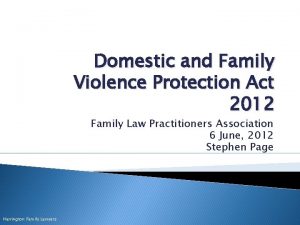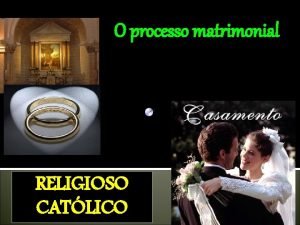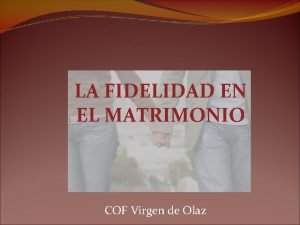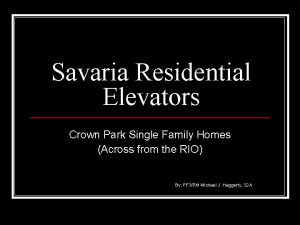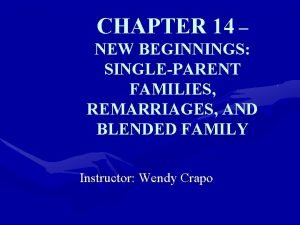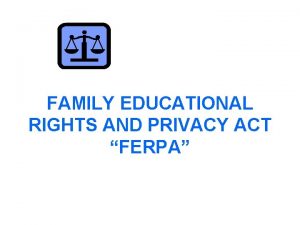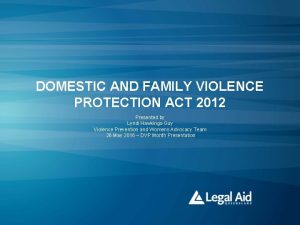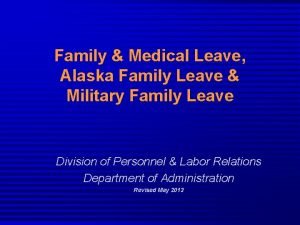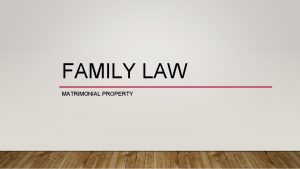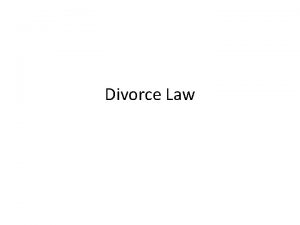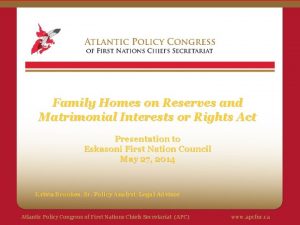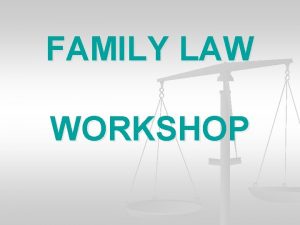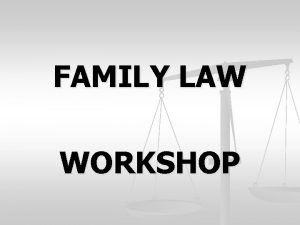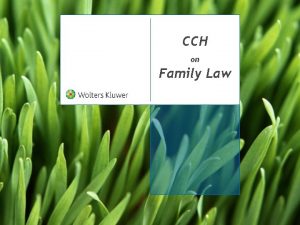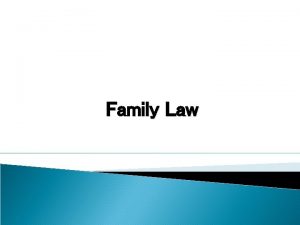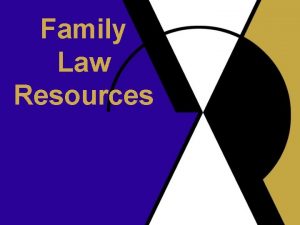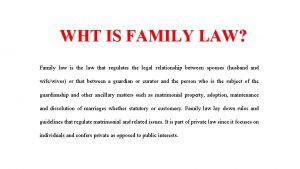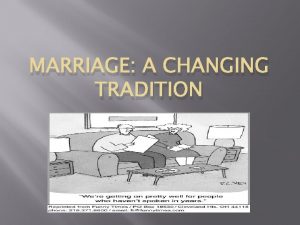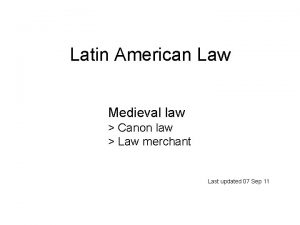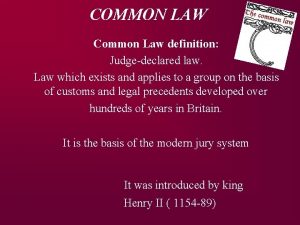Family Law Act Matrimonial Home A matrimonial home
































- Slides: 32

Family Law Act

Matrimonial Home �A matrimonial home is a home where a married couple lives � It is not necessary to designate a specific property since the primary residence of the married couple is a matrimonial home � All properties acquired after marriage except those gifted or inherited are equally divided, unless a contract to the contrary is signed (often known as a pre-nuptial agreement)

Matrimonial Home � Both husband wife automatically on the title of the property even if only one of their names is mentioned � Written consent from one’s spouse (known as Spousal Consent) is required to sell a matrimonial home � In case of a divorce, both parties will have a 50% ownership right, or a right to 50% of the sales proceeds

Matrimonial Home � If a property is gifted or inherited to one party during marriage, the other party cannot get a share after divorce � Properties purchased during marriage shall be split 50 -50 � Investment properties purchased besides the matrimonial home prior to marriage will be split 50 -50 unless a pre-nuptial agreement is signed

Matrimonial Home � For example, consider a single man who owns two properties prior to marriage. He gets married and the newly married couple moves into one of the properties, which subsequently becomes the matrimonial home. � If the couple gets divorced, the wife can get 50% of the net value of the matrimonial home. She can also get 50% of the increase in investment property, unless they were gifted or inherited

Limited Partnerships � Partners do not own an equal share of the business; they have unequal rights � Partner with smaller share has less control and requires consent to implement decisions � Partner � If with higher share has more control there are more than 3 partners with unequal shares, highest share holder can dominate but will require consensus with other partners

General Partnerships � Partners have equal rights under a general partnership � All partners have an equal share in the business � In case of a two-person general partnership, the partners enjoy a 50 -50 share in the business

� Under Limited vs. General a limited partnership, partners are liable up to how much money they have invested. Under general partnership, all the partners are responsible for all the debt � Limited partners cannot bind other partners, whereas general partners can bind all other partners � Limited partnerships must be registered and should have one partner with a majority ownership or stake

Real Estate vs. Real Property � Real Estate � Real Property ◦ Tangible (can be touched physically) ◦ Examples include land, buildings and structures ◦ Combination of tangible and intangible ◦ Intangible elements include rights over property, including right to use, sell, lease or occupy ◦ Examples include fixtures attached to homes, such as lights and built-in appliances, as well as personal property

Personal Property � It includes chattels on a property � Includes cars, boats, and refrigerators if they are not built in, furniture, clothes and books � Chattel is typically moveable in nature and not fixated to the land or structure. � Personal property, unlike fixtures, are not included in the agreement of sale and must be explicitly included if you want to sell them

Personal property vs. Fixtures �A salesperson shows a client a property. The client asks if the chairs and dining table are included in the sale. The salesperson says they are included, but once the transaction goes through, the seller removes them. � The seller is responsible if the furniture was built in since it is a fixture and included in the sale. The salesperson is responsible if the furniture is moveable since it was not explicitly included in the sales agreement.

Riparian Rights � Riparian rights are rights that land owners have to use water on, under or adjacent to their land � They include right to swim, right to fish and right to drink the water

Tenements � Dominant Tenement ◦ The property (tenement) or land that benefits from an easement � Subservient Tenement ◦ The property (tenement) or land which has the burden of an easement

� An Easements easement is a right of way that is exercised by the dominant tenement over the subservient tenement � The person who enjoys the right is dominant while the person who serves it is subservient � Easements exist over land or property, not � Easements stay with the property even when persons. sold

Easements � Dominant and subservient tenements do not need to be adjacent to one another, but they need to be within reasonable distance for an easement to exist � Easements give parties who do not own land the right to trespass on that land � Examples include easements given to landlocked homes for access to roads � One should consider easements before buying homes that are subservient tenements

Creating Easements � There are four ways to create easements 1. Express Grant • Subservient owner decides to grant easement in favor of dominant owner • Done through express (verbal or written) grant 2. Implication • Easement impliedly granted • If you sell a part of your home to someone else, they will have implied easement to use your driveway • Easement implied because the buyer would not be able to use land for intended purpose without it

Creating Easements 3. Prescription • Individual obtains easement right through adverse possession (squatting on the land) • It is obtained by means of its continuous exercise over a certain period of time • If you build a balcony that extends over your neighbor’s land, over time, you may obtain an easement over that land 4. Statute • Easements are also created by a number of provincial statutes enacted through legislation. • For instance, utility companies by law are allowed to install and maintain electricity cables • These easements do not require a dominant tenement • Easements cannot be created by expropriation

Terminating Easements � There are three ways to terminate easements 1. Merge �The dominant tenement and subservient tenement merge to form a single property �This means that the buyer owns both properties 2. Release �The subservient tenement is released by the dominant tenement 3. Ceasing of purpose �The right of way for which the easement existed ceases to serve its intended purpose

Restrictive Covenant � Restrictive covenants are restrictions placed on a property � They are “promises” preventing owners of property from doing certain things ◦ For instance, owners may be restricted from painting their property purple � If you sell a property, you may put a restrictive covenant against it ◦ Business properties are often sold with restrictions preventing new owner from setting up competing business

Profit A Prendre � Profit A Prendre is a right granted in writing to enter a property and remove something from the property � It is often granted to extract fruits, minerals and wood from land � It is like a lease, but allows for taking of profit from the property

Profit A Prendre �A landlord and a farmer agree that the farmer will be able to grow fruits on the land sell them in exchange for a monthly fee of $1, 000. The landlord sells the land. The farmer retains his right to sell the fruit if he continues to pay $1, 000 if the new buyer allows such use. � But what if the new buyer does not allow such use? If the seller gave notice of the contract and the buyer was aware of it, the use may continue.

Profit A Prendre � The use can continue if the buyer assumes the contract with the farmer from the seller. ◦ This is typically required by sellers so that the new buyer may be sued for breach by the farmer instead of the seller � Barry leases 200 acres of corn farm land to Miller. Barry does not harvest crops himself. Miller has equipment to harvest corn and so he leases property for five years. Lease provides Miller with the right to harvest corn in the current year, and grow and harvest corn for remaining four years

Encroachment � Encroachment is a type of right that arises from unauthorized entry onto properties of another � This � For right arises unknowingly instance, if you plant a tree in your land it grows into your neighbor’s home, you will have encroached their land

Escheat � Escheat is when the government takes land until a family member claims it � For instance, when the owner of a property dies without leaving a will, the government will take possession of the property till an heir, somebody from the deceased’s family, makes a claim for the property

Expropriation � Expropriation is when the government takes over private property for public use ◦ Recap: Expropriation is an exception to fee simple ownership � Government must give fair compensation to owners of expropriated private property ◦ Aggrieved owners may go to the Board of Negotiations if they think compensation is unfair ◦ Board of Negotiations is empowered with expropriating property under Expropriation Act

Expropriation � Land use restrictions do not apply to expropriated properties ◦ The crown does not face any restrictions with regards to the usage of land ◦ If they choose, they can expropriate an entire neighborhood to construct a large seaport

�A Condominium condominium is a fee simple ownership of a defined space within a multi-occupancy building such as a multiple dwelling in which portions used jointly (common elements ) are in common ownership with other owners � Buyer of a condo gains fee simple ownership of a single unit ◦ It can be tenancy in common or joint tenancy � Buyer also has common interest / co-ownership interest in common elements (gym, stairs, pool etc. ) ◦ Interest in common elements is only tenancy in common and not joint tenancy

Condominium � Condo unit owners are fee simple owners of their unit and collectively own the entire building (including its debts) � Condo unit owners may sell their unit but not the common elements, which must be removed from the sale ◦ You can sell your unit and tenancy in common interest in the common elements ◦ These are sold using one deed; no separate deed required for selling the unit and common elements

Condominium �A condominium registration has two elements: 1. Declaration • Declaration is the legal structure • It is often called the “condominium constitution” 2. Description • Description is a drawing (survey) �A condominium is registered when both declaration and description are registered

�A Co-Operative Co-Op is a kind of joint ownership whereby a property is owned by a corporation ◦ Members purchase shares in the corporation ◦ This gives them an interest in the property � You own a share in a unit because of which you are allowed to live in a specific unit as stated in an agreement ◦ It is different to condominium because in a Co-Op, you own a share and not an actual unit � Members granted rights because they own specific shares; they are not fee simple owners

Co-Operative � Co-Ops provide more security than rented properties in most cases ◦ Sought by people avoiding uncertainties of rent market, including expiry of lease and rent increases ◦ Residential Tenancy Act does not apply to them so they are not subject to rent increases ◦ They are a popular option with university campuses since they provide affordable housing to students � Co-Ops housing are frequently referred to as welfare

Co-Operative � Cooperatives are either: 1. With share capital (equity co-operative) • If the corporation is dissolved, all liabilities including mortgages and debts will first be paid off, after which profits from sale of land its structure(s) will be shared amongst shareholders 2. Without share capital (non-profit co-operative) • Aims to provide accommodation to members, not provide gains for members • If the corporation is dissolved (terminated, bankrupted, closed), it will first pay off liabilities (debts and mortgages) and then distribute leftover property
 Section 47 report
Section 47 report S68r family law act
S68r family law act Que son las cartas
Que son las cartas Habilitação matrimonial religiosa
Habilitação matrimonial religiosa Fases de la separacion matrimonial
Fases de la separacion matrimonial Verdica
Verdica Fidelidad en el matrimonio
Fidelidad en el matrimonio Macbeth act 2 summary
Macbeth act 2 summary Newton's first law and second law and third law
Newton's first law and second law and third law Si unit of newton's first law
Si unit of newton's first law Boyles law
Boyles law Constant in avogadro's law
Constant in avogadro's law Pengertian home care
Pengertian home care Perbedaan home care dan home visit
Perbedaan home care dan home visit Mobile home parks for sale in sc
Mobile home parks for sale in sc Plurals of flower
Plurals of flower Come home come home jesus is calling
Come home come home jesus is calling New mobile home sales oak springs mobile home community
New mobile home sales oak springs mobile home community Let's go to your house
Let's go to your house Jr rabbin imam pretre
Jr rabbin imam pretre She said that, home economics stands for the ideal home.
She said that, home economics stands for the ideal home. Home sweet home survive items
Home sweet home survive items Single family home elevators
Single family home elevators Virtual games to play on zoom
Virtual games to play on zoom Conjugal family
Conjugal family Varies from family to family on the periodic table
Varies from family to family on the periodic table Characteristics of single parent family
Characteristics of single parent family Bombay nursing home registration
Bombay nursing home registration Child youth and family services act
Child youth and family services act Ferpa
Ferpa Domestic and family violence protection act 2012
Domestic and family violence protection act 2012 Family educational rights and privacy act of 1974
Family educational rights and privacy act of 1974 Alaska family medical leave act
Alaska family medical leave act
